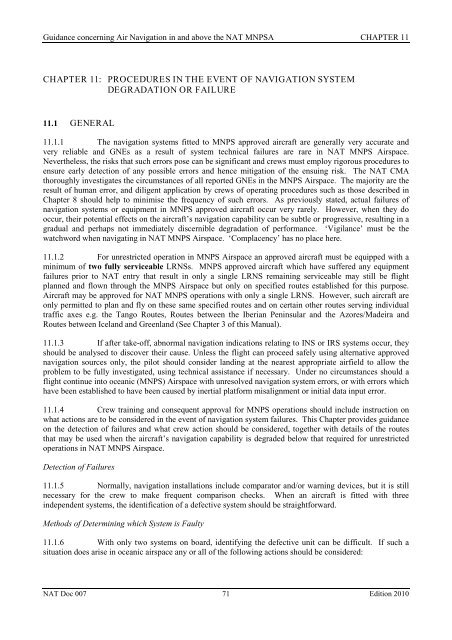World Air Ops | NAT | Doc 007 MNPS Guidance
World Air Ops | NAT | Doc 007 MNPS Guidance
World Air Ops | NAT | Doc 007 MNPS Guidance
You also want an ePaper? Increase the reach of your titles
YUMPU automatically turns print PDFs into web optimized ePapers that Google loves.
<strong>Guidance</strong> concerning <strong>Air</strong> Navigation in and above the <strong>NAT</strong> <strong>MNPS</strong>A CHAPTER 11CHAPTER 11: PROCEDURES IN THE EVENT OF NAVIGATION SYSTEMDEGRADATION OR FAILURE11.1 GENERAL11.1.1 The navigation systems fitted to <strong>MNPS</strong> approved aircraft are generally very accurate andvery reliable and GNEs as a result of system technical failures are rare in <strong>NAT</strong> <strong>MNPS</strong> <strong>Air</strong>space.Nevertheless, the risks that such errors pose can be significant and crews must employ rigorous procedures toensure early detection of any possible errors and hence mitigation of the ensuing risk. The <strong>NAT</strong> CMAthoroughly investigates the circumstances of all reported GNEs in the <strong>MNPS</strong> <strong>Air</strong>space. The majority are theresult of human error, and diligent application by crews of operating procedures such as those described inChapter 8 should help to minimise the frequency of such errors. As previously stated, actual failures ofnavigation systems or equipment in <strong>MNPS</strong> approved aircraft occur very rarely. However, when they dooccur, their potential effects on the aircraft’s navigation capability can be subtle or progressive, resulting in agradual and perhaps not immediately discernible degradation of performance. ‘Vigilance’ must be thewatchword when navigating in <strong>NAT</strong> <strong>MNPS</strong> <strong>Air</strong>space. ‘Complacency’ has no place here.11.1.2 For unrestricted operation in <strong>MNPS</strong> <strong>Air</strong>space an approved aircraft must be equipped with aminimum of two fully serviceable LRNSs. <strong>MNPS</strong> approved aircraft which have suffered any equipmentfailures prior to <strong>NAT</strong> entry that result in only a single LRNS remaining serviceable may still be flightplanned and flown through the <strong>MNPS</strong> <strong>Air</strong>space but only on specified routes established for this purpose.<strong>Air</strong>craft may be approved for <strong>NAT</strong> <strong>MNPS</strong> operations with only a single LRNS. However, such aircraft areonly permitted to plan and fly on these same specified routes and on certain other routes serving individualtraffic axes e.g. the Tango Routes, Routes between the Iberian Peninsular and the Azores/Madeira andRoutes between Iceland and Greenland (See Chapter 3 of this Manual).11.1.3 If after take-off, abnormal navigation indications relating to INS or IRS systems occur, theyshould be analysed to discover their cause. Unless the flight can proceed safely using alternative approvednavigation sources only, the pilot should consider landing at the nearest appropriate airfield to allow theproblem to be fully investigated, using technical assistance if necessary. Under no circumstances should aflight continue into oceanic (<strong>MNPS</strong>) <strong>Air</strong>space with unresolved navigation system errors, or with errors whichhave been established to have been caused by inertial platform misalignment or initial data input error.11.1.4 Crew training and consequent approval for <strong>MNPS</strong> operations should include instruction onwhat actions are to be considered in the event of navigation system failures. This Chapter provides guidanceon the detection of failures and what crew action should be considered, together with details of the routesthat may be used when the aircraft’s navigation capability is degraded below that required for unrestrictedoperations in <strong>NAT</strong> <strong>MNPS</strong> <strong>Air</strong>space.Detection of Failures11.1.5 Normally, navigation installations include comparator and/or warning devices, but it is stillnecessary for the crew to make frequent comparison checks. When an aircraft is fitted with threeindependent systems, the identification of a defective system should be straightforward.Methods of Determining which System is Faulty11.1.6 With only two systems on board, identifying the defective unit can be difficult. If such asituation does arise in oceanic airspace any or all of the following actions should be considered:<strong>NAT</strong> <strong>Doc</strong> <strong>007</strong> 71 Edition 2010
















